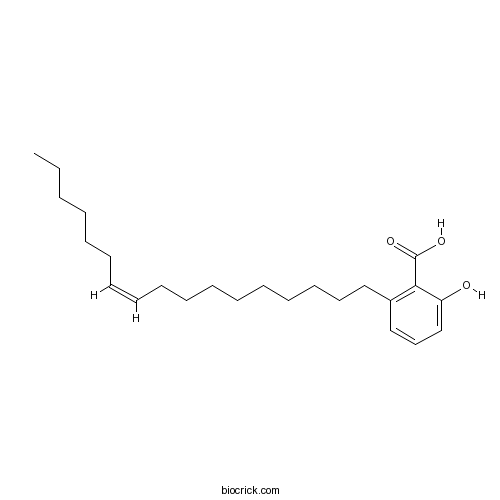Ginkgolic acid C17:1CAS# 111047-30-4 |

Quality Control & MSDS
3D structure
Package In Stock
Number of papers citing our products

| Cas No. | 111047-30-4 | SDF | Download SDF |
| PubChem ID | 5469634 | Appearance | White-yellowish powder or waxy |
| Formula | C24H38O3 | M.Wt | 374.56 |
| Type of Compound | Phenols | Storage | Desiccate at -20°C |
| Synonyms | Ginkgolic acid II; 6-(10Z)-Heptadecenylsalicylic acid | ||
| Solubility | Soluble in diethyl ether, ethanol, n-hexane, methanol and petroleum ether; sparingly soluble in acetone; practically insoluble in water | ||
| Chemical Name | 2-[(Z)-heptadec-10-enyl]-6-hydroxybenzoic acid | ||
| SMILES | CCCCCCC=CCCCCCCCCCC1=C(C(=CC=C1)O)C(=O)O | ||
| Standard InChIKey | MBYNDKVOZOAOIS-FPLPWBNLSA-N | ||
| Standard InChI | InChI=1S/C24H38O3/c1-2-3-4-5-6-7-8-9-10-11-12-13-14-15-16-18-21-19-17-20-22(25)23(21)24(26)27/h7-8,17,19-20,25H,2-6,9-16,18H2,1H3,(H,26,27)/b8-7- | ||
| General tips | For obtaining a higher solubility , please warm the tube at 37 ℃ and shake it in the ultrasonic bath for a while.Stock solution can be stored below -20℃ for several months. We recommend that you prepare and use the solution on the same day. However, if the test schedule requires, the stock solutions can be prepared in advance, and the stock solution must be sealed and stored below -20℃. In general, the stock solution can be kept for several months. Before use, we recommend that you leave the vial at room temperature for at least an hour before opening it. |
||
| About Packaging | 1. The packaging of the product may be reversed during transportation, cause the high purity compounds to adhere to the neck or cap of the vial.Take the vail out of its packaging and shake gently until the compounds fall to the bottom of the vial. 2. For liquid products, please centrifuge at 500xg to gather the liquid to the bottom of the vial. 3. Try to avoid loss or contamination during the experiment. |
||
| Shipping Condition | Packaging according to customer requirements(5mg, 10mg, 20mg and more). Ship via FedEx, DHL, UPS, EMS or other couriers with RT, or blue ice upon request. | ||
| Description | Ginkgolic acid C17:1 can significantly inhibit enterohemorrhagic Escherichia coli O157:H7(EHEC) biofilm formation on the surfaces of polystyrene and glass, and on nylon membranes. |
| Targets | Antifection |
| In vitro | Ginkgolic acids and Ginkgo biloba extract inhibit Escherichia coli O157:H7 and Staphylococcus aureus biofilm formation[Reference: WebLink]International Journal of Food Microbiology Volume 174, 17 March 2014, Pages 47–55Infection by enterohemorrhagic Escherichia coli O157:H7 (EHEC) is a worldwide problem, and there is no effective therapy. Biofilm formation is closely related to EHEC infection and is also a mechanism of antimicrobial resistance. |

Ginkgolic acid C17:1 Dilution Calculator

Ginkgolic acid C17:1 Molarity Calculator
| 1 mg | 5 mg | 10 mg | 20 mg | 25 mg | |
| 1 mM | 2.6698 mL | 13.349 mL | 26.698 mL | 53.396 mL | 66.745 mL |
| 5 mM | 0.534 mL | 2.6698 mL | 5.3396 mL | 10.6792 mL | 13.349 mL |
| 10 mM | 0.267 mL | 1.3349 mL | 2.6698 mL | 5.3396 mL | 6.6745 mL |
| 50 mM | 0.0534 mL | 0.267 mL | 0.534 mL | 1.0679 mL | 1.3349 mL |
| 100 mM | 0.0267 mL | 0.1335 mL | 0.267 mL | 0.534 mL | 0.6674 mL |
| * Note: If you are in the process of experiment, it's necessary to make the dilution ratios of the samples. The dilution data above is only for reference. Normally, it's can get a better solubility within lower of Concentrations. | |||||

Calcutta University

University of Minnesota

University of Maryland School of Medicine

University of Illinois at Chicago

The Ohio State University

University of Zurich

Harvard University

Colorado State University

Auburn University

Yale University

Worcester Polytechnic Institute

Washington State University

Stanford University

University of Leipzig

Universidade da Beira Interior

The Institute of Cancer Research

Heidelberg University

University of Amsterdam

University of Auckland

TsingHua University

The University of Michigan

Miami University

DRURY University

Jilin University

Fudan University

Wuhan University

Sun Yat-sen University

Universite de Paris

Deemed University

Auckland University

The University of Tokyo

Korea University
- 2-(2'-Hydroxy-4'-methylphenyl)propionic acid
Catalog No.:BCN7980
CAS No.:111044-84-9
- Annonacin
Catalog No.:BCN4734
CAS No.:111035-65-5
- Ruthenium Red
Catalog No.:BCC7067
CAS No.:11103-72-3
- Vitamin A2
Catalog No.:BCC8367
CAS No.:11103-57-4
- Pioglitazone
Catalog No.:BCC4927
CAS No.:111025-46-8
- Muricatide
Catalog No.:BCN1780
CAS No.:111025-01-5
- 2-Amino-1-phenylethanol
Catalog No.:BCN1779
CAS No.:7568-93-6
- Efonidipine hydrochloride monoethanolate
Catalog No.:BCC7767
CAS No.:111011-76-8
- (-)-Dihydroquercetin
Catalog No.:BCN3370
CAS No.:111003-33-9
- Deacetylsalannin
Catalog No.:BCN4733
CAS No.:1110-56-1
- Methyl Laurate
Catalog No.:BCC8211
CAS No.:111-82-0
- 1-Heptylamine
Catalog No.:BCN1801
CAS No.:111-68-2
- N-Benzoyl-2-hydroxy-2-phenylethylamine
Catalog No.:BCN1622
CAS No.:111059-46-2
- Fmoc-D-Lys(Trt)-OH
Catalog No.:BCC2594
CAS No.:111061-54-2
- Fmoc-Ser(Trt)-OH
Catalog No.:BCC3546
CAS No.:111061-56-4
- Dacomitinib (PF299804, PF299)
Catalog No.:BCC3683
CAS No.:1110813-31-4
- FERb 033
Catalog No.:BCC7701
CAS No.:1111084-78-6
- 14-Hydroxy sprengerinin C
Catalog No.:BCN2777
CAS No.:1111088-89-1
- NF 110
Catalog No.:BCC7404
CAS No.:111150-22-2
- PF-04880594
Catalog No.:BCC3998
CAS No.:1111636-35-1
- 1,2-O-Dilinoleoyl-3-O-beta-D-galactopyranosylracglycerol
Catalog No.:BCN6768
CAS No.:111187-15-6
- 7,3',4'-Trihydroxy-3-benzyl-2H-chromene
Catalog No.:BCN1621
CAS No.:1111897-60-9
- CGS 20625
Catalog No.:BCC7375
CAS No.:111205-55-1
- Episappanol
Catalog No.:BCN7940
CAS No.:111254-18-3


